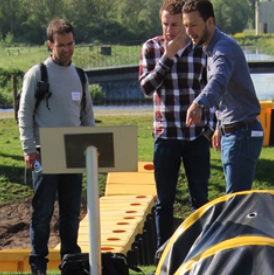A testing and implementation framework for assessing an innovation’s social and technical readiness

Introduction
Europe is particularly prone to natural hazards and evidence is now ever stronger that damages will increase in the future. Many innovations are being developed to reduce the risks associated with climate change, yet a large proportion fail to reach the market. This failure is due to a number of reasons like a lack of rigorous testing, or because innovators cannot assess whether institutions (policy and decision makers) and societies are ready to implement an innovation.
Currently there is no internationally accepted framework for assessing the readiness of innovations to reduce disaster risk. To fill this gap, the H2020 BRIGAID project(BRIdging the GAp for Innovations in Disaster resilience) has developed a standard, comprehensive Testing and Implementation Framework (TIF) to help assess the technical and societal readiness of innovations.
The TIF provides innovators with comprehensive guidelines and tools to evaluate the performance of an innovation to reduce risks from floods, droughts, or extreme weather in a real operational environment on a set of criteria.
Download a Policy Brief introducing TIF from the right-hand colum. Key details are provided below (see the full text for more detail).
How does the Tool work?
The TIF is designed to provide innovators, investors and end users with clear guidelines to assess an innovation’s technical effectiveness, societal acceptance, and socioeconomic and environmental impact.
- Technical readiness is the performance and effectiveness of an innovation to reduce climate-related risks, as shown in field tests and in real operational environments.
- Societal readiness is the extent to which the innovation complies with public and private end user priorities and needs, as well as the organizational and governance requirements.
- Market readiness is the potential of an innovation to develop a solid business case and help attract investors.
The tool comes readymade as a comprehensive package that includes a robust theoretical frame into a toolkit format as a set of guided questions that systematically evaluates the innovation´s performance based on a set of variables/criteria, as well as guidance and advice to help interpret the results from the assessment.
The TIF provides key performance indicators on the impacts to various sectors (see figure below). Also, the TIF provides guidance on the types of tests that can be used to advance the technological readiness to a more mature stage. The TIF has the advantage that it can be run early on – and then iteratively throughout the innovation development – helping innovators to modify their designs to avoid getting locked into designs that are less likely to appeal to investors and end users.
The self-assessment consists of twenty (20) questions related to societal acceptance, nineteen (19) questions related to technical design, twenty-one (21) questions related to environmental impacts, and twenty-four (24) questions related to sectoral impacts.
What does the TIF package include?
- The current and future socio-technical boundary conditions across Europe · Socio-technical Performance Indicators (PI)
- Testing protocols used to evaluate and/or quantify these Performance Indicators
- Guidelines to measure the impact of innovations on the environment and on various socio-economic sectors, including: agriculture, energy, forestry, nature/ecology/environment, health, infrastructure, and tourism
- Guidelines and tools (in the form of online questionnaires, testing templates, and spreadsheets) to create an innovation profile and assess its socio-technological readiness.

Development and testing
Our goal is that the TIF becomes the EU quality label that can in dialogue help innovators, investors and end users to assess the effectiveness of risk reduction innovations. The policy brief explains how the TIF helps bridge the adoption gap.
The TIF is being tested and improved in BRIGAID from a selection out of more than 75 innovations throughout Europe. Find out more on brigaid.eu and have a look at the selected innovations on our platform Climate Innovation Window.
(0) Comments
There is no content